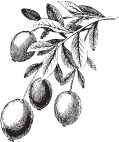
Following the Seasons: Fall and Winter
In the fall, after the work in the gardens was over, Mountain Wolf Woman and her family usually went to pick cranberries. This was another way to make money. When they arrived at a cranberry marsh, there often would be many Ho-Chunk families camping together. And everybody would pick berries—women, men, and children. The adults carried bushel-sized boxes at their sides. As they worked their way across the marsh, they left behind rows of filled boxes. Mountain Wolf Woman and the other children used small pails and picked the berries by hand and then put their berries into their mothers’ boxes. At noon, some would go back to camp to eat, but others brought lunches along and ate out in the marsh. Mountain Wolf Woman thought it was a lot of fun to pack a lunch and eat outside.

Cranberries
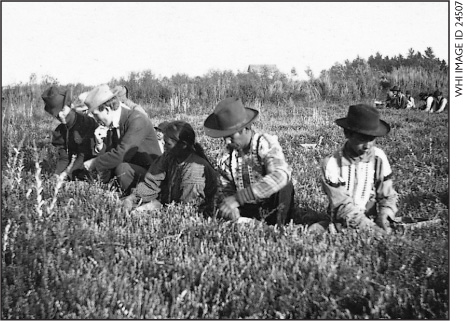
Ho-Chunk group harvesting cranberries
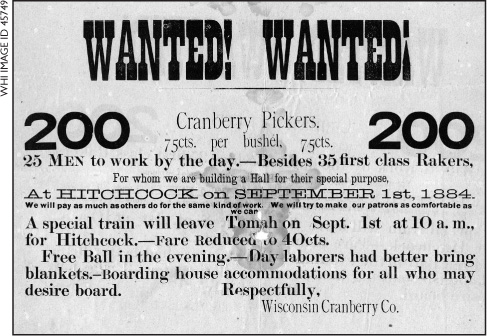
Notice for cranberry pickers
Mountain Wolf Woman really loved it when peddlers came to the cranberry marsh to sell things. Her favorites were the pies. She thought pies were great because her own family used to cook on campfires and could not bake pies and cakes. These baked goods were a real treat!
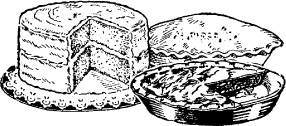
After cranberry-picking time, it was time for the fall move to hunt deer. Hunting deer is what Mountain Wolf Woman’s family and other Ho-Chunk families always did in the fall, just as their ancestors had done before them for countless years.
One place that they liked to hunt was in the woods outside of Neillsville, northeast of Black River Falls. There, Mountain Wolf Woman’s family and 4 or 5 other families would build wigwams. Her grandmother and mother made their wigwam and covered it with mats of woven cattails. The other families were her sisters and their husbands and children as well as other relatives. Mountain Wolf Woman loved being with her family. Mountain Wolf Woman’s family had so many people that they lived in a wigwam with 2 fireplaces. On cold nights, her father kept the fires going all night long, but the inside of the well-made wigwam was never too smoky. It was a good place to live.
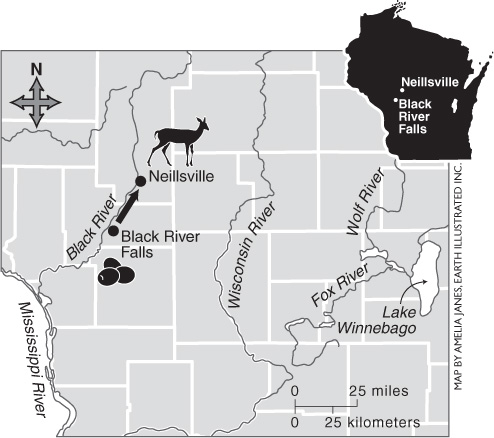
In the fall, Mountain Wolf Woman’s family left home to hunt deer.

Mats were important in Ho-Chunk culture. All the women owned mats that they had made themselves from cattail leaves or bulrush reeds. And all the young girls had to learn how to make mats. These woven mats had many uses. They were used as doors, to sit on, and to cover wigwams. They also spread mats on the ground to dry corn.
To make a mat out of bulrush reeds, the reeds had to be picked, cut, dried, cooked in boiling water, dried again, bundled up, dyed, and then woven. Some were decorated with geometric designs. It took a lot of time.

Wood strips were woven together to make mats.
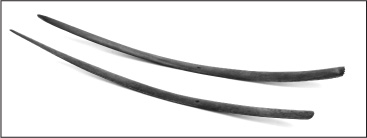
Needles used to make mats
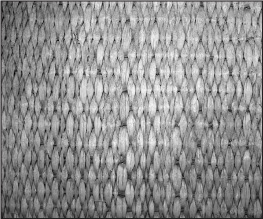
Close-up of finished mat

Hunting was considered men’s work, so only the men and boys hunted. When still young, boys learned how to hunt many kinds of animals from squirrels and rabbits to deer and bear. Mountain Wolf Woman remembered that the hunters used to find deer quickly. They always brought home some meat the first day. Back then, there were not as many hunters. Nobody needed a deer license. Her family killed as many deer as it needed. And sometimes it needed a lot! When Mountain Wolf Woman’s father and other hunters shot a deer, they wrapped it in leaves and carried the deer back to camp on their backs. Occasionally, they even brought back a bear.
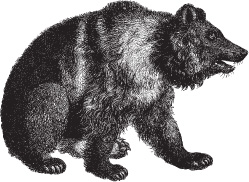
After hunting for a while in one place, sometimes the family would move its camp to hunt somewhere else. Mountain Wolf Woman’s father, mother, and older sisters and brothers all carried packs on their backs to make the move. One year, though, they got a pony, and the pony carried all of their belongings when they moved their camp. Sometimes the children got to ride on top of the pack. Do you think a pony could carry all of your family’s belongings? How many ponies do you think it would take?
Mountain Wolf Woman and her sisters and brothers used to fast during the time when the family was hunting. Among the Ho-Chunk people, fasting was a way to ask the spirits for a good life and sometimes to get power. Her parents encouraged all of their children to fast. Her brother Big Winnebago fasted from the fall to the early spring. During these months, he would not eat anything during the day. He would eat only after the sun went down.
Mountain Wolf Woman and her older sister Distant Flashes Standing fasted, too. When their father left in the morning to hunt, Mountain Wolf Woman and Distant Flashes Standing took coals from old, cold fires and blackened their cheeks. Blackening their faces was part of the fasting ritual. They fasted to receive blessings, and they blackened their cheeks so people would know not to offer them food.

Mountain Wolf Woman would have played with a doll like this one.
Distant Flashes Standing sat indoors and wove yarn belts, but Mountain Wolf Woman liked to play outside. At the end of the day, when their father returned from hunting, he used to say to them, “Go cry to the Thunders,” which meant, go pray to the spirits. And when he was ready to eat, he gave the girls tobacco and again told them to go pray. To the Ho-Chunk people and members of other Indian nations, tobacco is a sacred plant. Tobacco has special significance and is used as an offering to the spirits.
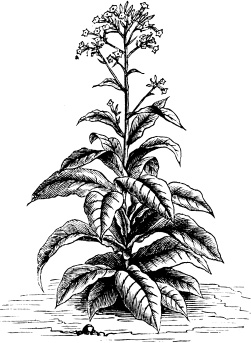
Tobacco plant
Mountain Wolf Woman and her sister went into the woods and looked at the dark night sky and cried to the Thunders. They sang, “Oh, good spirits. Will they pity me? Here I am, pleading.” They sang this because if the spirits had pity—that is, if the spirits felt sorry for them—then the spirits would give them a blessing. The girls then scattered tobacco and looked at the moon and stars. Thinking back on those times, Mountain Wolf Woman said, “We used to cry because, after all, we were hungry. We used to think we were pitied. We really wanted to mean what we were saying.” Then they went home and ate.
At night in the wigwam, Mountain Wolf Woman’s father told the children to prepare their bedding and lie down. There were no television sets or even radios, but her father told wonderful stories. These were good memories for Mountain Wolf Woman. She said, “I really enjoyed listening to my father tell stories.” Everyone in the whole family stayed quiet so that they could hear all of the words. The stories he told were sacred to the Ho-Chunk people. Many years later, Mountain Wolf Woman still thought fondly of these stories even though she said, “I do not know all of them any more, I just remember parts.”
She remembered one story about a Ho-Chunk man getting revenge after another tribe had killed everyone in his town. This man snuck into the other tribe’s town during the night and cut off the heads of the chief’s son and daughter-in-law! And then he took their heads and went up to the moon. Mountain Wolf Woman’s father told her that on nights when the moon was full, she could look up and see the man carrying the 2 heads in his hand. Go check out the next full moon. What do you see?
Hunting came to an end when the winter was at its coldest and there was a lot of snow. It was then that Mountain Wolf Woman and her family left their hunting camp and went back to their home near Black River Falls. They spent the coldest winter months warm in their own log house.

After the hunting season, it was time for the winter feast. Seasonal feasts and ceremonies played a big part in Mountain Wolf Woman’s childhood. Feasts were important ways that Ho-Chunk people made offerings to the spirits. Spring, fall, and winter feasts were also known as war-bundle feasts or ceremonies.
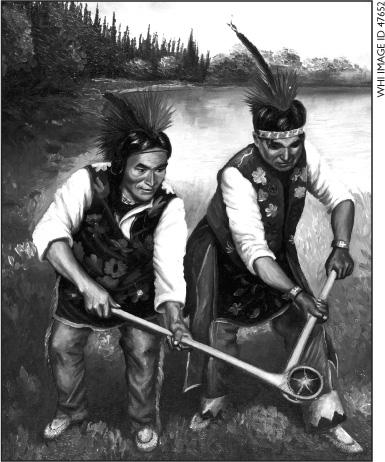
Lacrosse was a game enjoyed by many Wisconsin Indians. Ho-Chunk men and women played it on ceremonial occasions.

Many generations in the past, ancestors tied the first war bundles. War bundles consist of animal skins or hides wrapped around items important to a family. The bundles contain items such as pipes, feathers, animal bones, and, in more recent times, such things as soldiers’ medals. Succeeding generations add to the bundle. The war bundle offers protection and blessings to the entire family group.
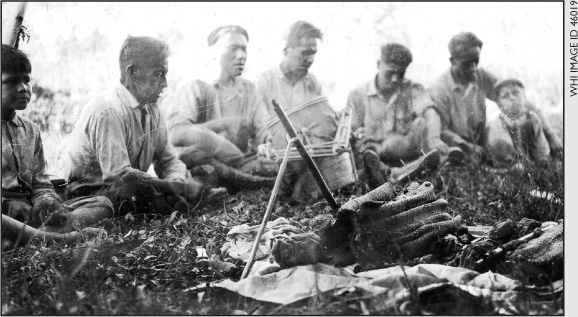
The items in the center are part of the war bundle.

Mountain Wolf Woman remembered that her father used to give large feasts. He built a special long wigwam for the winter feast. And for this work, her father had help from his nephews. Remember, for the Ho-Chunk, relationships among family members mean particular duties and privileges. Nephews are expected to work for their uncles, that is, their mother’s brothers. (Among the Ho-Chunk, father’s brothers were called father, not uncle.)
Mountain Wolf Woman remembered one winter feast that was held in a wigwam long enough to hold 8 fireplaces! Many Ho-Chunk people came, so Mountain Wolf Woman’s father fed a whole wigwam full of people. Mountain Wolf Woman remembered that he provided 10 deer for one such feast! Many deer meant people could make offerings to more spirits. The winter feast lasted overnight. People gave speeches, danced, and sang, and they offered tobacco, specially prepared deer hides, and prayers to the spirits. It was a time for clan members to come together. Mountain Wolf Woman enjoyed being part of this large family group.
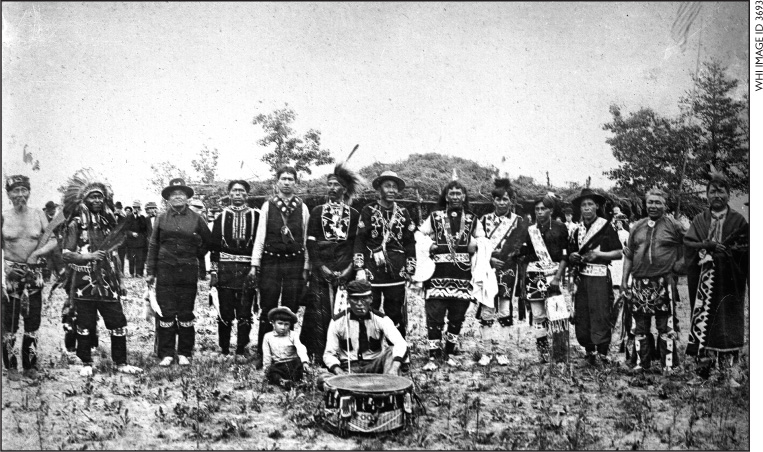
Ho-Chunk dressed in their ceremonial clothes
Sometimes people fasted before feasts and then broke their fasts at the feast. Mountain Wolf Woman remembered a time when her brothers Big Winnebago and Strikes Standing fasted in the woods before a feast. Boys fasted to obtain a vision. Mountain Wolf Woman’s father built a shelter for them to live in, and they were supposed to stay there all by themselves for 4 nights! But Strikes Standing did not have the patience to wait 4 nights, and he came home early. Bends the Bough was upset with him for not following this tradition, and she cried. Like all parents, perhaps even your own, she was worried that her child was making wrong choices. But Big Winnebago stayed until it was feast time.
Despite all of their hunting, gathering, and gardening during the year, sometimes Mountain Wolf Woman’s family did not have much food. In remembering his own childhood, Big Winnebago said that was why he became such a fast eater. The family always ate out of just one dish, so he learned to eat quickly to get enough. How would your family do if you had to hunt, plant, and gather all of your food? You might have hungry times, too.